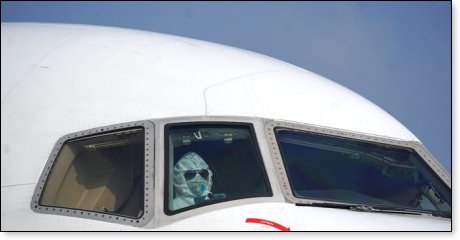How airplane travel circulates airborne disease
Barbara Kralis, RenewAmerica analyst

In the old days during the Golden Age of Airline Travel, in the early and mid-1960s, all U.S. airlines allowed their pilots to direct fresh outside air at 35,000 altitude to circulate and refresh the inside cabin air.
Passengers felt great flying. No one got sick like they do today. I worked as a stewardess during that era, walking hundreds of miles serving and helping passengers feel comfortable. For millions of Americans, it was such a joy to fly off into the wild blue yonder. The air inside the cabins was gloriously clean. People smoked on the planes, even cigars were allowed, but my hair and clothing never smelled bad after the day's schedule ended.
Why? Fresh air from 35,000 feet up was allowed to circulate freely into the cabins.

Not anymore. In order to save fuel costs, airlines stop letting any outside air into the cabins. Then passengers and crew started getting sick. The old air was re-circulated over and over for hours throughout the cabin.
If a passenger back in row #38 was sick with a virus, everyone inside the cabin became exposed as droplets circulated throughout the entire cabin, blowing out of overhead air vents into passengers' faces.
Passengers got sick. People suffered low energy from lack of fresh oxygen. It wasn't the pleasant experience it once used to be.
In addition, incidences of passengers contracting the once eradicated TB disease increased from airline travel. Think of the other viruses that we breathe onboard today as dirty recycled cabin air blows onto us for hours.
Better than wearing a tight fitting N-95 surgical mask, President Trump could do a great service to travelers by mandating all U.S. airlines once again allow 100% fresh outside air to circulate inside the cabins.

© Barbara Kralis
March 10, 2020

In the old days during the Golden Age of Airline Travel, in the early and mid-1960s, all U.S. airlines allowed their pilots to direct fresh outside air at 35,000 altitude to circulate and refresh the inside cabin air.
Passengers felt great flying. No one got sick like they do today. I worked as a stewardess during that era, walking hundreds of miles serving and helping passengers feel comfortable. For millions of Americans, it was such a joy to fly off into the wild blue yonder. The air inside the cabins was gloriously clean. People smoked on the planes, even cigars were allowed, but my hair and clothing never smelled bad after the day's schedule ended.
Why? Fresh air from 35,000 feet up was allowed to circulate freely into the cabins.

Not anymore. In order to save fuel costs, airlines stop letting any outside air into the cabins. Then passengers and crew started getting sick. The old air was re-circulated over and over for hours throughout the cabin.
If a passenger back in row #38 was sick with a virus, everyone inside the cabin became exposed as droplets circulated throughout the entire cabin, blowing out of overhead air vents into passengers' faces.
Passengers got sick. People suffered low energy from lack of fresh oxygen. It wasn't the pleasant experience it once used to be.
In addition, incidences of passengers contracting the once eradicated TB disease increased from airline travel. Think of the other viruses that we breathe onboard today as dirty recycled cabin air blows onto us for hours.
Better than wearing a tight fitting N-95 surgical mask, President Trump could do a great service to travelers by mandating all U.S. airlines once again allow 100% fresh outside air to circulate inside the cabins.

© Barbara Kralis
RenewAmerica analyst Barbara Kralis also writes a column for RenewAmerica.
The views expressed by RenewAmerica columnists are their own and do not necessarily reflect the position of RenewAmerica or its affiliates.
(See RenewAmerica's publishing standards.)
